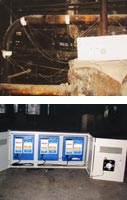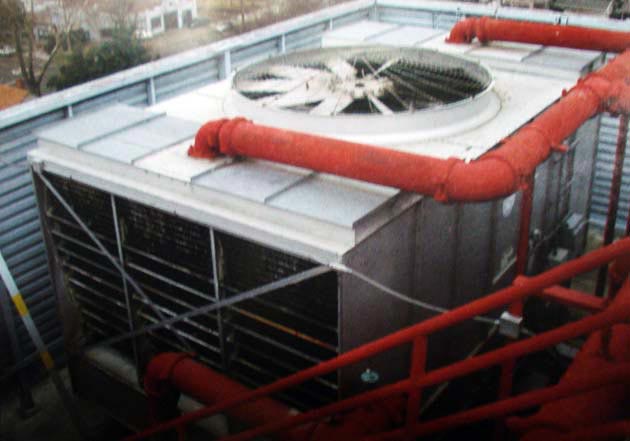

UB'CAL ELECTRONIC WATER CONDITIONER - APPLICATIONS - COMMERCIAL
COMMERCIAL APPLICATIONS
 The UB’Cal Water conditioner are specifically designed for hard water problems the UB’Cal water conditioner is a water softener alternative.
The UB’Cal Water conditioner are specifically designed for hard water problems the UB’Cal water conditioner is a water softener alternative.
This provides whole house hard water scale prevention as well as prevent hard water scale built-up. This is a true alternative to sodium based water softeners.
What UB’Cal Water Conditioner can do for your had water.
- No Chemicals or salt to add.
- No polluting chemicals to drain.
- No wastewater produced.
- No drain line to install.
- Provides whole house water treatment.
- Provides healthier drinking water at every faucet in your home.
- Eliminates harmful effects of hard water scale
- Improves plant growth.
- Prevents bathtub ring.
- Installed on the main supply line of your house
- Provides excellent grooming and cosmetic benefits.
- Reduces water heating costs.
- Excellent for agriculture purpose.
- Reduces existing scales build up
- Creates crystal clear water.
HARD WATER
The primary problems associated with the use of water are related to hardness high soap consumption, poor cleaning, scale formation, etc. UB’Cal Water Conditioner treats the hardwaters by converting the hardness from a dissolved contaminant to a sub- micron suspended solid that literally washes through the plumbing system before it can react and form a scale or interfere with the action of soaps and detergents. When the calcium hardness is turned to a suspended solid the surface tension of the water is reduced. There is also an effect on surface tension caused by a UB’Cal Water Conditioner generated. The lower surface tension causes water to rise higher in a fine tube conventionally referred to as wetter water plants get greener and all living cells can get more water in a shorter period of time.
Due to the water acting "Softer " after the UB’Cal Water Conditioner soaps, detergents and cleaning chemicals perform more efficiently as a result less is required.
CALCIUM
Water is the greatest solvent known. Whenever it goes it dissolves small particles of everything it contacts. Two of the most common minerals dissolved are calcium and magnesium. These dissolved minerals go on to redeposit on pipes, hot water systems, household appliances and any other surface with building up a lime scale.
This lime scale in industry reduces efficiency of equipment, increases fuel requirements and increases maintenance time and costs. Maintaining scale free surfaces allows maximum heat transfer and utilization of equipment in other areas this lime scale build up reduces the interior diameter of the pipe leading to inefficiency, blockage, and even total destruction of the pipe or appliance.
IRON
Installation of the UB’Cal Water Conditioner will keep submersible pumps free of iron build-up eliminating the necessity of having, to pull the pump up for cleaning in some cases up to three times a year. UB’Cal water conditioners will stop iron build up in pipelines, micro and drip irrigation equipment, stop the staining of plants and in some cases decrease staining of buildings and fences.
Application of UB’Cal Water Conditioner In Boilers
WHAT IS UB’Cal WATER TREATMENT ?
The buildup of scale deposits is a common and costly problem in many industrial processes using natural water supplies the formation of scales in industrial process plant where water is heated results in extra heat consumption i.e. decaling or the poor thermal conductivity of decreased by 95% by a CaCO3 scale layer 25 mm thick whereas an Sio2 scale layer 0.5 mm thick results in a 90% decrease in heat transfer. Scale formation is the precipitation of sparingly soluble salts, most commonly calcium carbonate, which form an encrustation on susceptible surfaces. Most commonly this occurs as a result of temperature or PH changes, influencing the solubility of the scale former. Other common scale-forming compounds include calcium sulphate, barium sulphate, calcium phosphate, magnesium hydroxide, zinc phosphate, iron hydroxides and silica, all of which occur naturally in-raw water supplies, the activated silica is capable of adsorbing an abundant amount of dissolved minerals. Thus a small amount of activated silica can neutralize a large amount of calcium. Thus the periodic introduction of additional activated silica through the makeup pipe. Serves to keep the mineral neutralization process working until the coagalated silica hydrosol drops out as sludge by the force of gravity, further, activated silica, along with the improved solvency of the water serves to pull scale off tower parts and back into the solution to be neutralized. In the cooling tower water remains in the process for a considerable time allowing for flocculate and finely coagulation to occur. In a house or boiler, the water passes rather quickly through the structure and the treated water is only able to flocculate.
Boiler Systems
All types of boilers may be equipped with a UB’Cal Water Conditioner system for successful elimination of scale formation and corrosion, without the use of other chemicals for treatment. After UB’Cal Water Conditioner treatment, boiler matter does not (when heated) produce a hard scale on the walls of boiler or in heating pipes, but rather a loose sludge which settles to the bottom and can easily be removed, or flushed by a simple blow-down without acid treatment.
Even extremely impure grades of water can be used, as there is no tendency towards scaling after the water has passed through the UB’Cal Water Conditioner system.
UB’Cal Water Conditioner treatment is already widely used in boilers for all purposes. The advantages over conventional treatment are that no analysis of the water is required. The labor requirement is severely reduced as compared with the constant attention required by conventional dosing and ion-exchange plants.
The cost-savings advantages of these benefits are probably obvious to anyone familiar with boiler maintenance and should not require detailed delineation here. Different types of boilers and installations will benefit in different areas and to different degrees depending upon their particular circumstance and functions.
Cooling Towers and Condensers
A cooling tower looses water through evaporation (to achieve cooling) and through drift (water droplets carried away by wind and fan). Thus, water has to be added to compensate for the loss. Since all cooling water contain dissolved solids, unless previously removed, the evaporation will concentrate these dissolved solids in the cooling systems. High concentrations will result in scale formation in the heat exchanger and in the tower.
Heat Exchanger
A heat exchanger is a device that transfers heat between two media, while keeping them physically separated. In a refrigeration system it removes from the compressed refrigerant gas, the heat of compression and the heat absorbed by the refrigerant is hereby converted back into the liquid phase so the heat exchanger is properly called a condenser. Deposits on tubes in a condenser cause tremendous loss of heat transfer efficiency resulting in inefficient cooling of the refrigerant which in turn causes higher compressor head pressure. Higher head pressure will create a large increase in power consumption.


Go To Top